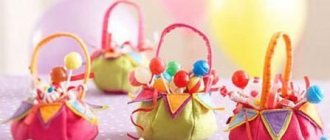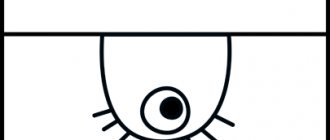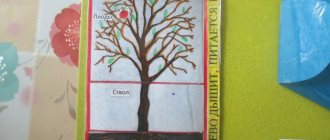Ekaterina Yurievna
Card index of educational design games
Card No. 1
"Complete the house"
Didactic task:
Learn to convey a symmetrical structure
at home, focusing on its half, notice
differences in details (shape and size of windows, doors, etc.)
.
Material:
Cards depicting halves of different houses
architecture and colors, wall blocks with windows or
doors of different shapes and sizes, and half roofs.
Cards with outline images of entire houses and
free cards of the same size , separated
line in half.
Game description:
The leader distributes the players into two teams and
invites you to sit at the table opposite each other.
Places wall blocks for all houses on a common tray and
half roofs. Each child is given a picture of one
half of the house, and the other is depicted in outline (all houses
different architectures).
You need to assemble the second half of the house yourself.
Then change places with each other and finish
"construction" of his partner's house, so that the house
turned out to be symmetrical.
After finishing work, check the card correctly
whether the task has been completed.
Card No. 2
Do you have it or not?
Goal: To teach children to recognize objects of familiar shape by touch.
Material: Two muffs; two sets of simple shaped objects (ball, apple, pear, egg, lemon, pyramid, cube, brick, etc.)
; box.
Progress:
Option 3. (st., preg. gr)
The first player does not name the part, but describes it. For example: “I have a part in which two sides are triangles, and three sides are rectangles.” The second player names the part and looks for it in his muff. After this, both players take out the parts and check the correctness of the solution to the problem.
Card No. 3
Stroke.
Goal: To introduce children to the ability of geometric shapes to “transform”
into various subjects. Development of imagination. Dictionary development. Preparing your hand for writing.
Material: Geometric shapes. Colour pencils.
Progress: The teacher tells the children some story or fairy tale (the topic is chosen by the teacher)
. Then the children are given a geometric figure (or several, they are asked to circle it and finish drawing it so that they get a hero of the story or an object.
Notes: The game can be used by all age groups.
Card No. 4
Architect.
Goal: To develop the ability to compose a serial series. Train your child in the ability to create a construction plan.
Material: Strips of different lengths (up to 10 gradations)
; a sheet of paper, a simple pencil.
Progress:
Option 1. (Wed, old class)
Arrange the strips in disarray. Invite the children to arrange them in order: from smallest to largest or from largest to smallest.
Option 2. (st., preg. gr.)
Arrange the strips in disarray. Invite the children to draw a plan for the staircase without touching the stripes. Then, offer to take the strips and build the stairs according to the plan.
Card No. 6
Find out the subject.
Goal: Recognize a schematically depicted object. Build an item from builder parts; make up of geometric shapes.
Material: Schematic images of various objects; geometric figures; construction details.
Progress:
Option 1. (cf. gr.)
Show the child a picture with a schematically depicted object. The child names the object, says what geometric shapes it can be made from, and constructs it.
Option 2. (st., preg. gr.)
The child recognizes a schematically depicted object and builds it from the builder’s parts, independently selecting the necessary parts.
Card No. 5
Find out what has changed? (art., subg. gr.)
Goal: To train children in correctly determining the spatial arrangement of objects: to the right, to the left, in front, behind, on the side, near, etc. To develop observation and active memorization. Fix the name of geometric shapes or construction parts.
Material: Geometric shapes or details of a wooden constructor ; Parsley; screen.
Progress: Children help Parsley figure out where the objects are. Behind the screen, objects change places. Only those children whom Parsley points out name the change in the arrangement of objects.
Complication: The number of parts increases; swaps the places of more than two objects.
Card No. 7
What is this length? Width? Heights? (art., subg. gr.)
Goal: To teach children to pay attention not only to the overall size of an object, but also to its individual parameters - length, width, height.
Material: Strips of different lengths.
Move: An adult makes a wish for some object (for example: a table)
and makes a narrow paper strip equal to its length. To guess the mystery, the child will need to compare the length of different objects in the group with this strip. Then you can guess another object by measuring its height and the next one by measuring its width.
Card No. 8
Hot - cold. (old age)
Purpose: To reinforce in children the names of the parts of a wooden construction set . Develop coherent speech.
Material: Designer ; matryoshka
Procedure: Examine the details with the children, place them so that they are clearly visible and so that they can be approached.
V. – today we will play the game “Hot - Cold”
.
Let's choose a driver. He will go out the door, and we will hide the nesting doll behind some detail. If he sees a nesting doll behind a part, he must name it, and only after that can it be taken. We will help the driver, if he has gone far away - we will say: “Cold”
, if close -
“Warm”
, if very close -
“Hot”
.
The leader is chosen using a counting rhyme. The number of parts depends on the age and level of preparedness of the children.
Card number 10
Find the building according to the description.
Goal: Learn to find a building according to its description; develop observation skills; learn to describe a building without naming it; cultivate endurance.
Material: Ready-made buildings (in the sub-group, you can use volumetric diagrams)
; Pinocchio toy.
Progress: The teacher, together with Pinocchio and the children, examines the buildings. At the same time, the teacher pays attention to what parts the building consists of, how they are located relative to each other, what functional parts there are, and why this item is needed.
V. – Now Pinocchio and I will make a wish for one of the buildings, and Pinocchio will tell you about it. The one whom Pinocchio points to will name the hidden building. Pinocchio describes the building - the children guess.
Option.
The child describes the building. Pinocchio guesses. The game continues until all buildings have been guessed. Then Pinocchio offers the children small toys to play with the buildings.
Card No. 9
Happy Island. (old age)
Goal: Development of imagination. Skill to work in team. Reinforcing the names of geometric shapes.
Material: Multi-colored geometric shapes and their parts.
Progress: The teacher determines the topic. Children create a building together. The construction must correspond to the nature of the theme.
Card No. 11
Guess what was built?
Goal: to develop the method of synthesis through the analysis of proposed buildings.
You need to: out of three images of castles consisting of different figures, color only the one that consists of the proposed figures.
Card number 12
Different houses. (old age)
Purpose: To teach children to compare a drawing and a drawing (diagram)
subject.
Material: Cards with outline images of buildings of complex shape (houses with different roofs, extensions)
.
Children are offered 4 schemes. Three detailed pictures for each diagram . In each picture there is a slight discrepancy with the diagram: the difference is in the shape of the roof of one of the extensions, in the location of the extensions, in their height, etc. Procedure
: An adult tells the children that once the builders were building a house according to the drawing and made small mistakes. And although the houses turned out beautiful, they were still a little different from the drawing. Offers to examine each building and find inaccuracies. The teacher shows the children the first diagram and a picture for it . Children find a mistake. Then the teacher shows the next picture for the same diagram , then the third. Next, move on to the second diagram and examine three more pictures . If the children cannot find the correct answer, the teacher helps them. The rest of the drawings and drawings are treated in the same way.
In this game you can use a variety of drawings and designs.
Card number 13
Guess what. (old age)
Goal: Teaching children to adhere to a certain plan when analyzing an object, i.e., sequentially asking a series of questions, first of a general nature - about the purpose of the object, its external appearance as a whole, more specific ideas - about the parts of the object, their features and structure.
Material: A set of drawings depicting various objects, buildings (a hut on chicken legs, an airplane, a swing, an ice palace, a bridge, etc.)
Progress: The pictures are placed in front of the children. An adult invites children to play the game “Guess”
.
He will guess the object that the children will choose from several shown in the pictures . The adult asks questions, and the children answer only “yes”
or
“no
.” Questions could be something like: “Is this an ordinary object? - No. Is this a fairy tale item? - Yes. Is it used for transportation? - No. Do they live in it? - Yes. Is it on chicken legs? - Yes. Is this Baba Yaga's hut? - Yes".
Card number 14
"Build according to the model"
Purpose of the game: to teach children to build structures using ready-made
models.
Material: three-dimensional models, construction
constructor.
Theoretical aspects of training
Paper construction (paper-plastic) is a type of activity for preschoolers that involves:
- drawing up an action plan;
- selection of materials for crafts;
- performing manipulations using the chosen technique.
In kindergarten, children construct crafts in classes organized by the teacher in a playful way.
Lesson objectives
Before planning a lesson, the teacher must set a goal that he wants to achieve. It is implemented through several tasks.
Educational objectives:
- introduce the properties of different types of paper (classic, velvet, holographic, crepe);
- develop the ability to cut out the necessary parts for a craft and name them (square, circle, etc.);
- clarify ideas about colors and their names;
- learn to make three-dimensional shapes from paper blanks by bending, crumpling, twisting or tearing them;
- encourage the creation of products according to plan (independently choose the theme and material for the craft);
- learn to combine elements into a composition (for example, roads and houses are a street).
Correction and development tasks:
- develop fine motor skills, thinking, attention and memory;
- improve visual and tactile perception;
- develop the ability to analyze created crafts and, based on this, plan your further actions;
- develop imagination.
Educational tasks:
- develop the ability to maintain order in the workplace and put tools in their place after finishing work;
- cultivate kindness, love of nature, etc. (depending on the craft).
Types of paper designs
Paper plastic is divided into 2 types:
- origami - folding figures by bending paper;
- volumetric paper and cardboard modeling, involving the use of scissors and glue.
Design forms
There are 7 forms of organizing constructive activities:
- Pattern design developed by F. Fröble. The teacher’s actions serve as an example. Children repeat what is shown, learning new techniques for working with various materials.
- Model design proposed by A. N. Mirenov. Instead of a sample, a model is used in classes - a ready-made craft. The method for creating the product is not shown. Students must recreate the model themselves. This form of organizing activities is used when working with children 5-6 years old and older. It helps to activate the thinking of preschoolers, because... they need to mentally disassemble the product into its components and reproduce the procedure unknown to them.
- Design according to conditions, developed by N. N. Poddyakov. He suggested not giving children ready-made samples and ways to solve a problem. The underlying conditions must be problematic in nature. For example, students are asked to make an object out of paper that can be given to their mother on March 8th. This method allows you to develop thinking and imagination. It is used if children have already made given objects or analyzed products that are similar in structure.
- Design based on drawings and visual diagrams. The authors of the method are S. Leon Lorenzo and V. V. Kholmovskaya. When working with preschoolers, templates are used. Children learn to use drawings as a way of understanding an object and how to create it.
- Design by design. For kindergarten students, this activity is difficult. In order for them to think creatively, the teacher must form in children an idea of the objects being created, the ability to repeat the teacher’s actions and look for new ways to create crafts. Only after preschoolers have mastered the existing methods of paper modeling will they be able to creatively use the knowledge they have acquired.
- Design on the topic. This form is close to making crafts by design. The difference is that the teacher limits the idea to the topic. For example, a teacher invites children to create any craft on the theme “Autumn.”
- Frame design proposed by N. N. Poddyakov. This method is rarely used when working with preschoolers. The teacher shows a frame made of any material, and then does something that changes the structure. With such training, children learn not only the structure of the frame, but also how to change it.
Disadvantages of design in preschoolers
Through systematic, well-organized activities, children overcome the following shortcomings of their personal design attempts:
- the child’s plan is unclear, the structure of the image is also blurred;
- the design tends to be unstable (preschoolers begin to construct one object, but as a result they create another and are happy with it);
- excessive haste and enthusiasm for the activity itself, which distracts from the overall intent of the activity;
- vague ideas about the sequence in which actions should be performed and how they should be planned;
- Children do not know how to pre-analyze the task at hand.
If these shortcomings are not overcome, then the child will continue to engage in construction at a very low level.
Preschoolers can take part in two types of design: artistic design and technical design.
Motivation for children
To make it interesting for preschoolers, you can turn the activity into a game: bring a toy (hero) and invite the children to make a house or a gift for him.
It is important that children understand the practical significance of their activities. They will be more motivated if they know that their product can be given to an adult (mom, dad, grandmother, etc.).
The importance of design in the formation of a child’s personality
Construction, more than other types of activities, prepares the ground for the development of children's technical abilities, which is very important for the comprehensive development of the individual.
Biographies of many outstanding technical inventors show that these abilities sometimes manifest themselves even in preschool age. An example is the childhood of outstanding inventors: A. S. Yakovlev, I. P. Kulibin, V. A. Gasiev, T. A. Edison and others. What are some important personality qualities that are formed in the constructive and technical activities of adults, especially in activities of a creative nature, and lay the foundation for the formation of technical abilities?
The creative constructive and technical activity of adults is characterized by subtle observation, developed on the basis of great accuracy of perception and understanding of the technical essence of objects.
The designer must be able to imagine not only the structure of the machine, the design, but also the technical side of them: how, with what help are the parts held together? Which one is the main one for the entire structure? By what means is the mobility of parts and the structure as a whole achieved? How are all parts of the structure located not only in the frontal plane, but also in three-dimensional space?
Constructive and technical activities require relatively high concentration of attention. Before you start creating a structure, you need accurate calculations and thoughtfulness; when performing it, a certain consistency and accuracy in work is required. Any inaccuracy leads to serious miscalculations.
Creative constructive and technical activity of adults is characterized by developed spatial imagination, expressed in the ability to voluntarily operate with images of spatial imagination in accordance with the set goal. Before constructing a new machine, the creator must clearly visualize it and mentally follow the operation of the machine. Only after being convinced of a successful solution to the design problem as a whole does the designer agree to transform what he mentally created into a real product.
The designer’s imagination must be both extremely concrete and extremely abstract, i.e. he must have not only developed spatial imagination, but also a high degree of flexibility of thinking, which manifests itself not only in the ability to mentally create various specific variations of the general design of the machine, but also in the ability to promptly refuse such options that are impossible to implement under given conditions.
Technical abilities are characterized by emotional and volitional personality traits. They are expressed in interest in constructive activity, in the satisfaction that a person experiences when creating or improving any structure of social significance. Awareness of social significance in the creation of a new invention causes the inventor’s creative activity and desire to achieve his goal. Moreover, this responsibility manifests itself even when the designer or inventor has no interest in this type of technology.
The above qualities of a future designer begin to develop in children under the guidance of a teacher. Teaching children to design is of great importance in preparing children for school, developing their thinking, memory, imagination and ability for independent creativity.
During constructive activities, children form generalized ideas about the objects that surround them. They learn to generalize groups of homogeneous objects based on their characteristics and at the same time find differences in them depending on practical use. Each house, for example, has walls, windows, doors, but houses differ in their purpose, and therefore in their architectural design. Thus, along with common features, children will also see differences in them, that is, they acquire knowledge that reflects significant connections and dependencies between individual objects and phenomena.
In terms of preparing children for school, constructive activity is also valuable because it develops the ability to closely connect acquired knowledge with its use, the understanding that knowledge is simply necessary for success in activity. Children are convinced that the lack of necessary knowledge about the subject, constructive skills and abilities is the reason for failures in creating a structure, an uneconomical method of its manufacture, and poor quality of the result of the work.
During constructive activity classes, a preschooler develops important qualities; the ability to listen to the teacher, accept a mental task and find a way to solve it.
An important point in the formation of educational activity, as proven in research by employees of the Research Institute of Preschool Education of the Academy of Pedagogical Sciences of the USSR, is the reorientation of the child’s consciousness from the final result that must be obtained during a particular task to the methods of implementation. This phenomenon plays a decisive role in the child’s development of awareness of his actions and their results. The main focus of children's attention is the process itself and how to complete the task. They begin to understand that when completing a task, not only the practical result is important, but also the acquisition of new skills, knowledge, and new ways of acting.
Switching children's consciousness to ways to solve a constructive problem forms the ability to control their activities taking into account the task at hand, that is, self-control appears. This excludes mechanical performance of work in a once memorized way, simple imitation of a friend. The child is already able, as N.N. Poddyakov notes, “to analyze his actions, highlight their essential links, consciously change and rearrange them depending on the result obtained.” This makes it possible to teach children not only individual specific actions, but also general principles, patterns of action and prepares the child to understand his cognitive processes. The child learns to control his mental processes, which is an important prerequisite for successful schooling.





